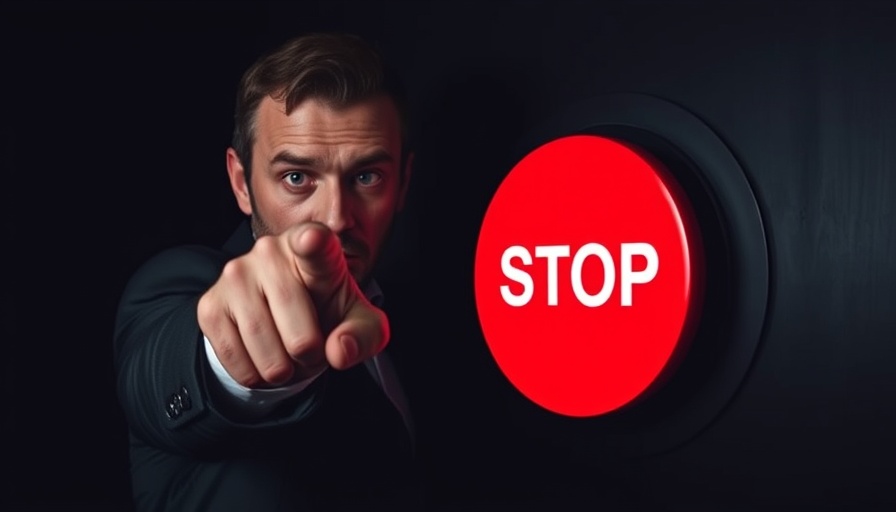
Rethinking Anxiety: The Importance of Micro Habits for Mental Wellness
Navigating through trauma or anxiety can often feel like steering an overly sensitive car alarm that blares at the slightest provocation. For many, daily life is consumed by feelings of hypervigilance, frustration, and exhaustion. Fortunately, there are actionable steps we can take to retrain our nervous system to find balance and peace amidst the chaos. Inspired by the video titled "9 Micro Habits for Self-Regulation of Trauma or Anxiety," this article explores effective micro habits that professionals can implement to manage stress and cultivate emotional resilience.
In "9 Micro Habits for Self-Regulation of Trauma or Anxiety," the discussion dives into transformative habits that can aid in managing anxiety and trauma, sparking deeper analysis on effective strategies to enhance mental wellness.
Why Micro Habits Matter in Mental Health Management
Micro habits are small, manageable actions that can have a significant impact on one's mental health over time. By making conscious, positive choices daily, individuals can gradually retrain their nervous systems from a state of hyperarousal to one of calmness and safety. Instead of merely trying to suppress feelings of anxiety or trauma, the focus shifts to fostering proactive behaviors that support overall well-being.
Setting the Tone for Your Day
One of the paramount habits to implement is how you start your day. A chaotic morning can heighten cortisol levels and predispose you to a more anxious state throughout the day. Instead of racing out of bed to face your to-do list, spend a few minutes in quiet reflection, meditation, or gentle movement. This habit sets a healthier tone and creates a buffer against stress as the day progresses. It’s crucial to replace the trauma-induced behavior of rushing with intentionality and calm.
Scheduling Downtime: The Key to Recovery
In our busy lives, we often forget the importance of rest. Professionals may fill their schedules to the brim, operating under the assumption that constant activity equals productivity. However, studies show that allocating time for rest—at least 10% of your day—can significantly improve efficiency and emotional regulation. Whether it’s a short walk or a moment spent meditating, prioritizing rest is an essential micro habit that counters trauma-driven behavior.
Practicing Mindfulness Through Frequent Check-Ins
A disconnection from oneself is common among those grappling with anxiety or trauma. Incorporating regular check-ins can help reconnect you to your bodily sensations and emotional state. Utilize a gentle reminder chime throughout the day to pause and reflect on how you are feeling physically and emotionally. This practice builds emotional awareness and strengthens your capacity for self-regulation.
Fostering a Sense of Safety
Many individuals with trauma experience heightened hypervigilance, always scanning for potential danger. To counteract this, building a sense of safety is vital. Engage in grounding techniques by observing your surroundings—mention three things you can see, touch, and hear. Having small objects that signify safety or using affirmations such as "I am safe right now" can reinforce this practice.
The Role of Community and Co-Regulation
Isolation can amplify the effects of anxiety and trauma, making social connection essential. Co-regulation occurs when emotional support is shared between individuals. Whether it’s a hug from a loved one or a chat with a trusted friend, social engagement can be a powerful anchor during tumultuous moments. Developing a plan to reach out when feeling overwhelmed can help reinforce feelings of safety.
Implementing Evening Wind Down Rituals
The end of the day is an excellent opportunity for reflection and emotional processing. Dedicate time for activities like journaling or practicing gratitude before bed. These rituals allow you to evaluate the day, focus on positive experiences, and unwind, effectively easing stress. Consider techniques like progressive muscle relaxation or a visualized safe place to help you transition to a restful state.
Your Path to Emotional Well-Being
As we unpack these nine micro habits, remember that improvement is gradual and personal. Choose one habit that resonates most with you, practice it consistently, and see how it influences your wellbeing. The journey toward mental wellness is not linear; it’s essential to approach this process with compassion and tolerance for yourself.
For those interested in further exploring strategies for self-regulation and emotional wellness, visit therapyinshell.com for free resources and courses.
 Add Row
Add Row  Add
Add 




Write A Comment